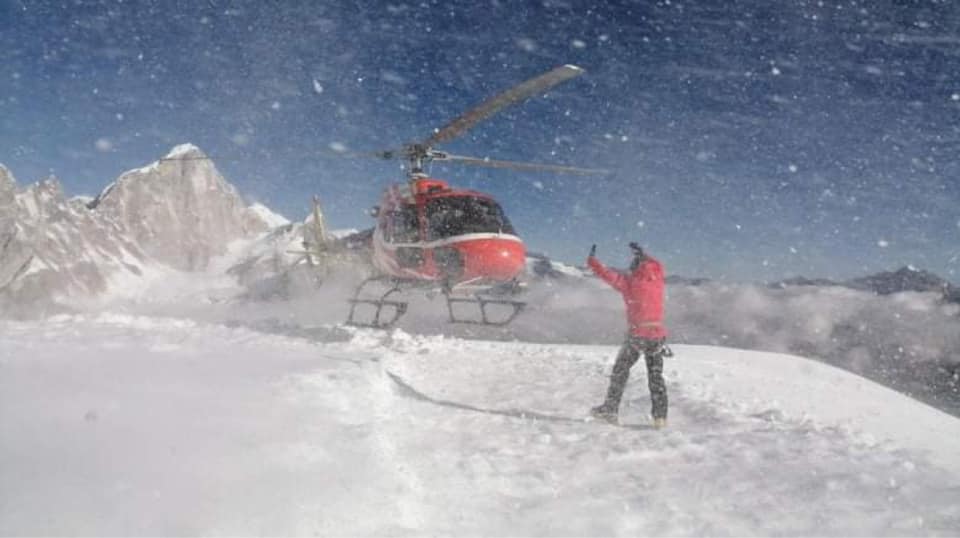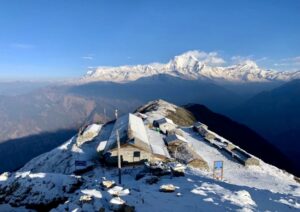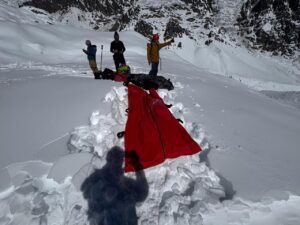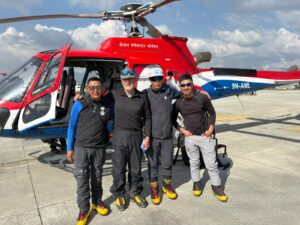The massive avalanche that took seven lives on Yalung Ri, a trekking peak in Rolwaling Valley, has prompted shock and grief, but also anger. Trekking operators, survivors, and locals have complained about a lack of accurate information and unacceptable delays in obtaining the permits required to launch rescue helicopters.
“The disaster struck on the morning of November 3 as a team of climbers was ascending a steep ice slope near the summit of Yalung Ri,” The Tourism Times reported. “However, the emergency response was immediately snared in red tape because the Rolwaling Valley is designated a restricted zone, requiring multiple layers of permission for rescue flights.”
The climbing leader from the Dreamers Destination team, Nima Gyalzen Sherpa, spoke to the paper from hospital. He said that injured climbers had to wait 24 hours for evacuation. Other witnesses confirmed the delays.
Several injured
Fuchs radioed base camp many times asking for helicopters to rescue the injured climbers. “Unfortunately, due to administrative issues [to obtain] a rescue permit to a restricted area, and with weather conditions deteriorating down the valley, the helicopter arrived at the end of the day,” Fuchs wrote.
Evacuations on October 4
“Two survivors [who were less badly injured] could get down [without the helicopter] and two severely injured were taken to base camp by helicopter,” Fuchs said. “A tent was set up at the avalanche site to spend the night.”
Fuchs returned to base camp for the night, and the pilot parked the helicopter in Na village, the usual starting point for expeditions in Rolwaling. The following morning, the helicopter airlifted everyone to Kathmandu.
Fuchs criticized some Nepali media that stated that she and the team leader were dead. “Disgusting, poor behavior only made things worse,” she said.
Even information shared by official sources that day was incomplete and inaccurate. They shared casualty figures and their nationalities, but no names, and some of the nationalities were wrong. This created confusion and anxiety for those with friends or relatives on the mountain.
Red-tape nightmare
Fuchs explained that expedition leader Phurba Tsering Sherpa, who was in Na village, struggled to organize the aerial rescue because obtaining the permits proved a slow and complex task. A helicopter pilot explained to The Tourism Times that you need to obtain permits to fly in Rolwaling from the Ministry of Tourism and the Civil Aviation Authority of Nepal, but you also need approval from the Ministry of Defense and the Home Ministry.
IFMGA guide Mingma G, a native of Rolwaling, wrote bluntly about the problem online: “The seven climbers were killed by the government, not the avalanche.”
After the avalanche on Yalung Ri. Photo: The Tourism Times
Later, he clarified what he meant to ExplorersWeb. “If there was no necessity of going through a long process to fly helicopters, more people could have been saved,” he said. “The helicopter from Kathmandu to Yalung Ri base camp takes around 45 minutes; a helicopter could have been at the accident area by 10 am. Instead, solving the bureaucratic issues took almost the entire day, and the helicopter only flew to Rolwaling at around 4 pm.”
Several areas restricted
Restrictions to helicopter flights are common in Nepal: Narphu (Himlung Himal), Mustang, Dolpo, Kanchenjunga, and Manaslu areas are also affected, and the restrictions are not only for visitors, but are applicable to locals as well. “I had the same problem when I needed to evacuate my mother to the hospital,” Mingma G told ExplorersWeb.
Mingma G at Everest Base Camp. Photo: Imagine Nepal
The government imposed the restrictions because of security concerns. These regions are on the border with Tibet. However, it negatively impacts isolated communities. Last year, villagers in the Manaslu region organized protests and blocked helipads used by foreign climbers, claiming the tourists were free to use helicopters while they could not, even for emergencies.
Helipad blocked in the Khumbu. Photo: Ama Dablam Youth Club
Abandoned Rolwaling
Mingma G is calling for Nepal’s government to amend the regulations.
“It takes two days of walking to reach my home [in Rolwaling] from the last road, and everything has to be carried by mules or porters. We are away from road, education, health services, electricity, and internet,” Mingma said.
He believes that 90% of the population will migrate to Kathmandu and fears the valley will soon be empty. “We need more tourists in the Rolwaling area. Accidents [like the avalanche] will negatively affect tourism.”
Climber Felix Berg during a recent expedition to Numbur, Rolwaling, with yaks carrying their gear. Photo: Adam Bielecki
Recovery mission
The government granted another helicopter permission to fly to Yalung Ri yesterday. Four Nepalese rescuers headed to the mountain, aiming to find and recover bodies. Rescuers already retrieved the remains of Paolo Cocco of Italy and Christian Andre Manfredi of France, but five others remain on the mountain: Italian-Canadian Marco Di Marcello, German Jakob Schreiber, Italian Markus Kirchler, and Nepalese Padam Tamang and Mere Karki.
Rescuers from the Nepal National Mountain Guides Association and helicopter pilot Priya Adhikari. Photo: The Tourism Times






